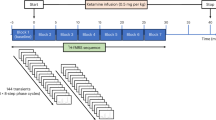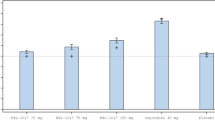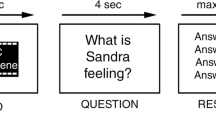Abstract
The interplay of opiate and NMDA glutamate receptors may contribute to psychosis, cognitive function, alcoholism, and substance dependence. Ketamine and ethanol block the NMDA glutamate receptor. The purpose of this randomized double-blind, placebo-controlled human laboratory study was to evaluate whether the interactive effects of drugs acting at opiate and NMDA glutamate receptors might partially explain the efficacy of naltrexone for the treatment of alcoholism, that is, whether naltrexone 25 mg pretreatment would modulate ketamine effects in healthy human subjects. Two groups of healthy subjects were studied. An initial group (n=31) received a perception-altering subanesthetic dose of ketamine (bolus of 0.23 mg/kg over 1 min followed by a 60-min infusion of 0.58 mg/kg or saline bolus and infusion). A second group (n=24) completed the same testing procedures, but received a subperceptual ketamine dose (bolus 0.081 mg/kg over 10 min followed by an infusion of 0.4 mg/kg/h). Ketamine produced positive symptoms, negative symptoms, emotional discomfort, and cognitive effects as measured by the Positive and Negative Syndrome Scale (PANSS) in a dose-related fashion. The lower ketamine dose produced subjective effects similar to two standard ethanol drinks, whereas the higher ketamine dose produced effects similar to five standard drinks. Although naltrexone produced no significant behavioral effects, it significantly magnified the increase in the total PANSS score produced by the lower subperceptual dose of ketamine, but not the higher perception-altering dose of ketamine. These data suggest that the interplay of opiate receptor antagonism and NMDA receptor antagonism may be relevant to the protective effects of naltrexone on alcohol consumption via potentiation of dysphoric effects associated with the NMDA receptor antagonist effects of ethanol. However, these data suggest that at levels of NMDA receptor antagonism associated with heavy drinking, this protective effect of naltrexone on drinking is no longer present.
Similar content being viewed by others
Log in or create a free account to read this content
Gain free access to this article, as well as selected content from this journal and more on nature.com
or
References
Ananthan S, Kezar HSI, Carter RL, Saini SK, Rice KC, Wells JL et al (1999). Synthesis, opioid receptor binding, and biological activities of naltrexone-derived pyrido- and pyrimidomorphinans. J Med Chem 42: 3527–3538.
Anton RF, Moak DH, Waid LR, Latham PK, Malcolm RJ, Dias JK (1999). Naltrexone and cognitive behavioral therapy for the treatment of outpatient alcoholics: results of a placebo-controlled trial. Am J Psychiatry 156: 1758–1764.
Bell MD, Lysaker PH, Beam-Goulet JL, Milstein RM, Lindenmayer JP (1994). Five-component model of schizophrenia: assessing the factorial invariance of the positive and negative syndrome scale. Psychiatry Res 52: 295–303.
Brandt J (1991). The Hopkins Verbal Learning Test: development of a new memory test with six equivalent forms. Clin Neuropsychol 5: 125–142.
Brunner E, Domhof S, Langer F (2002). Nonparametric Analysis of Longitudinal Data in Factorial Experiments. Wiley: New York.
Byrd LD, Standish LJ, Howell LL (1987). Behavioral effects of phencyclidine and ketamine alone and in combination with other drugs. Eur J Pharmacol 144: 331–341.
Fidecka S (1987). Opioid mechanisms of some behavioral effects of ketamine. Pol J Pharmacol Pharm 39: 353–360.
France CP, Woods JH (1989). Discriminative stimulus effects of naltrexone in morphine-treated rhesus monkeys. J Pharmacol Exp Therapeut 250: 937–943.
Fratta W, Casu M, Balestrieri A, Loviselli A, Biggio G, Gessa GL (1980). Failure of ketamine to interact with opiate receptors. Eur J Pharmacol 61: 389–391.
Gracy KN, Svingos AL, Pickel VM (1997). Dual ultrastructural localization of mu-opioid receptors and NMDA-type glutamate receptors in the shell of the rat nucleus accumbens. J Neurosci 17: 4839–4848.
Hance AJ, Winters WD, Quam DD, Benthuysen JL, Cadd GG (1989). Catalepsy induced by combinations of ketamine and morphine: potentiation, antagonism, tolerance and cross-tolerance in the rat. Neuropharmacology 28: 109–116.
Huang J, Wang H, Pickel VM (2000). Rostrocaudal variation in targeting of N-methyl-D-aspartate and mu-opioid receptors in the rat medial nucleus of the solitary tract. J Comparat Neurol 421: 400–411.
Hustveit O, Maurset A, Oye I (1995). Interaction of the chiral forms of ketamine with opioid, phencyclidine, sigma and muscarinic receptors. Pharmacol Toxicol 77: 355–359.
Jolas T, Aghajanian GK (1997). Opioids suppress spontaneous and NMDA-induced inhibitory postsynaptic currents in the dorsal raphe nucleus of the rat in vitro. Brain Res 755: 229–245.
Kay SR, Opler LA, Lindenmayer JP (1989). The Positive and Negative Syndrome Scale (PANSS): rationale and standardisation. Br J Psychiatry—Supplement 7: 59–67.
Kiefer F, Jahn H, Tarnaske T, Helwig H, Briken P, Holzbach R et al (2003). Comparing and combining naltrexone and acamprosate in relapse prevention of alcoholism: a double-blind, placebo-controlled study. Arch Gen Psychiatry 60: 92–99.
King AC, Volpicelli JR, Frazer A, O'Brien CP (1997). Effect of naltrexone on subjective alcohol response in subjects at high and low risk for future alcohol dependence. Psychopharmacology 129: 15–22.
Krystal JH, Cramer JA, Kroll W, Kirk G, Rosenheck RA, Group VANCS (2001). Naltrexone in the treatment of alcohol dependence. N Engl J Med 345: 1734–1739.
Krystal JH, D'Souza DC, Petrakis IL, Belger A, Berman R, Charney DS et al (1999). NMDA agonists and antagonists as probes of glutamatergic dysfunction and pharmacotherapies for neuropsychiatric disorders. Harvard Rev Psychiatry 7: 125–133.
Krystal JH, Karper LP, Seibyl JP, Freeman GK, Delaney R, Bremner JD et al (1994). Subanesthetic effects of the noncompetitive NMDA antagonist, ketamine, in humans psychotomimetic, perceptual, cognitive, and neuroendocrine responses. Arch Gen Psychiatry 51: 199–214.
Krystal JH, Petrakis IL, Limoncelli D, Webb E, Gueorgueva R, D'Souza DC et al (2003a). Altered NMDA glutamate receptor antagonist response in recovering ethanol dependent patients. Neuropsychopharmacology 28: 2020–2028.
Krystal JH, Petrakis IL, Mason G, D'Souza DC (2003b). NMDA glutamate receptors and alcoholism: reward, dependence, treatment, and vulnerability. Pharmcol Therapeut 99: 79–94.
Krystal JH, Petrakis IL, Webb E, Cooney NL, Karper LP, Namanworth S et al (1998). Dose-related ethanol-like effects of the NMDA antagonist, ketamine, in recently detoxified alcoholics. Arch Gen Psychiatry 55: 354–360.
Lee MC, Wagner Jr HN, Tanada S, Frost JJ, Bice AN, Dannals RF (1988). Duration of occupancy of opiate receptors by naltrexone. J Nucl Med 29: 1207–1211.
Marek GJ, Aghajanian GK (1998). 5-Hydroxytryptamine-induced excitatory postsynaptic currents in neocortical layer V pyramidal cells: suppression by mu-opiate receptor activation. Neuroscience 86: 485–497.
Martin CS, Earleywine M, Musty RE, Perrine MW, Swift RM (1993). Development and validation of the Biphasic Alcohol Effects Scale. Alcohol Clin Exp Res 17: 140–146.
Martin G, Nie Z, Siggins GR (1997). mu-Opioid receptors modulate NMDA receptor-mediated responses in nucleus accumbens neurons. J Neurosci 17: 11–22.
O'Malley SS, Jaffe AJ, Chang G, Schottenfeld RS, Meyer RE, Rounsaville B (1992). Naltrexone and coping skills therapy for alcohol dependence. A controlled study. Arch Gen Psychiatry 49: 881–887.
O'Malley SS, Jaffe AJ, Rode S, Rounsaville BJ (1996). Experience of a ‘slip’ among alcoholics treated with naltrexone or placebo. Am J Psychiatry 153: 281–283.
Petrakis IL, Limoncelli D, Guerguieva R, Jatlow P, Boutros NN, Trevisan L et al (2004). Altered NMDA glutamate receptor antagonist response in individuals with a family vulnerability to alcoholism. Am J Psychiatry 161: 1776–1782.
Sepulveda J, Ortega A, Zapata G, Contreras E (2002). Acamprosate decreases the induction of tolerance and physical dependence in morphine-treated mice. Eur J Pharmacol 445: 87–91.
Shannon HE, Holtzman SG (1977). Further evaluation of the discriminative effects of morphine in the rat. J Pharmacol Exp Therapeut 201: 55–66.
Smith DJ, Pekoe GM, Martin LL, Coalgate B (1980). The interaction of ketamine with the opiate receptor. Life Sci 26: 789–795.
Spitzer RL, Williams JBW, Gibbon M, First MB (1990). Structured Clinical Interview for DSM-III-R-Non-Patient Edition (SCID-NP, Version 1.0 with supplement for DSM-IV). American Psychiatric Press: Washington, DC.
Stella L, Crescenti A, Torri G (1984). Effect of naloxone on loss of consciousness induced by i.v. anesthetic agents in man. Br J Anesthes 56: 369–373.
Swift RM, Whelihan W, Kuznetsov O, Buongiorno G, Hsuing H (1994). Naltrexone-induced alterations in human ethanol intoxication. Am J Psychiatry 151: 1463–1467.
Trujillo KA, Akil H (1995). Excitatory amino acids and drugs of abuse: a role for N-methyl-D-aspartate receptors in drug tolerance, sensitization and physical dependence. Drug Alcohol Dependence 38: 139–154.
Volpicelli JR, Alterman AI, Hayashida M, O'Brien CP (1992). Naltrexone in the treatment of alcohol dependence. Arch Gen Psychiatry 49: 876–880.
Volpicelli JR, Watson NT, King AC, Sherman CE, O'Brien CP (1995). Effect of naltrexone on alcohol ‘high’ in alcoholics. Am J Psychiatry 152: 613–615.
Yamakura T, Sakimura K, Shimoji K (1999). Direct inhibition of the N-methyl-D-aspartate receptor channel by high concentrations of opioids. Anesthesiology 91: 1053–1063.
Young AM, Masaki MA, Geula C (1992). Discriminative stimulus effects of morphine: effects of training dose on agonist and antagonist effects of mu opioids. J Pharmacol Exp Therapeut 261: 246–257.
Acknowledgements
This work was supported by the National Institute on Alcohol Abuse and Alcoholism via RO1 AA12308-01, KO5 AA 14906-01, and I-P50 AA-12870-04. It is also supported by the Department of Veterans Affairs via support for the Alcohol Research Center, Schizophrenia Biological Research Center, and National Center for PTSD. The authors thank Angelina Genovese, RN, and Elizabeth O'Donnell, RN, of the Biological Studies Unit of the VA Connecticut Healthcare System for their contributions to the success of this project. The authors also thank Ms Corie Palazollo for her expert assistance in the preparation of this manuscript.
Author information
Authors and Affiliations
Corresponding author
Rights and permissions
About this article
Cite this article
Krystal, J., Madonick, S., Perry, E. et al. Potentiation of Low Dose Ketamine Effects by Naltrexone: Potential Implications for the Pharmacotherapy of Alcoholism. Neuropsychopharmacol 31, 1793–1800 (2006). https://doi.org/10.1038/sj.npp.1300994
Received:
Revised:
Accepted:
Published:
Issue date:
DOI: https://doi.org/10.1038/sj.npp.1300994
Keywords
This article is cited by
-
Influence of combined treatment with naltrexone and memantine on alcohol drinking behaviors: a phase II randomized crossover trial
Neuropsychopharmacology (2020)
-
Urothelial toxicity of esketamine in the treatment of depression
Psychopharmacology (2020)
-
Are Alcohol Anti-relapsing and Alcohol Withdrawal Drugs Useful in Cannabinoid Users?
Neurotoxicity Research (2016)
-
Glutamate NMDA receptor modulators for the treatment of depression: trials and tribulations
Psychopharmacology (2015)
-
The organic cation transporter 3 (OCT3) as molecular target of psychotropic drugs: transport characteristics and acute regulation of cloned murine OCT3
Pflügers Archiv - European Journal of Physiology (2014)



